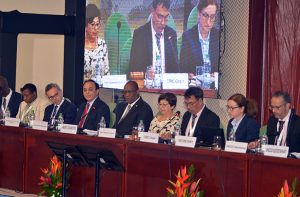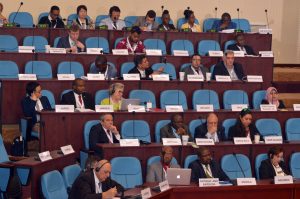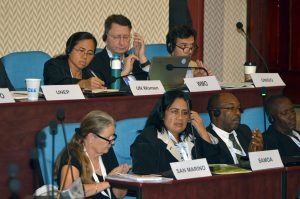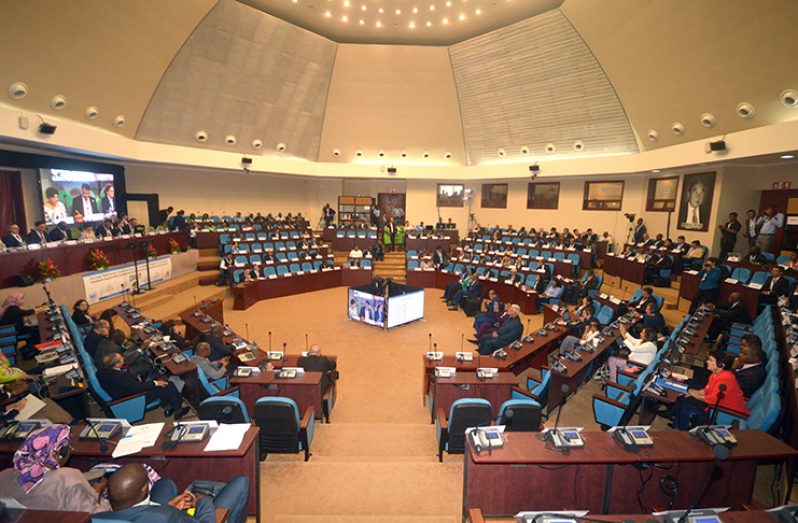…Min. Harmon says Guyana playing leading role in desertification
THE importance of land preservation and what it means to each country, their people and the course of their future took the forefront of the opening ceremony of the Committee for the Review of the Implementation of the Convention (CRIC17) of the United Nations Convention to Combat Desertification (UNCCD) in Guyana on Monday.

The hosting of the conference took place at the Arthur Chung Conference Centre (ACCC) and is the first of its kind in the Caribbean. It saw participation of delegates from some 125 countries who will meet during the next three days to examine the UN’s desertification issues such as land degradation and drought.
Also attending the event was UNCCD Executive Secretary Monique Barbut and other executive heads; Minster of State Joseph Harmon and other Ministers of Government; UN head of agencies; members of the diplomatic corps and other observers.
In his remarks to the gathering, Minister of State, Joseph Harmon, first established Guyana as a country in a strategic position to advance the climatic well-being of the planet. Guyana, he noted, is home to a portion of a 270-million-hectare eco-region known as the Guyana Shield, and what has been described as the “the lungs of the earth”, as it remains crucial to the “carbon clean-up”.
With the country’s land preservation goals in mind, he noted that it continues to partner with countries such as Norway, Germany, The Netherlands and Japan as well as other international organisations to advance the protection of its large forested lands.
“We therefore, have a deep appreciation for our unique position and the crucial nature of our responsibility in relation to the preservation of our land cover and the protection of our environment. We are, as well, fully aware of the importance of the implementation of the United Nations Convention to Combat Desertification to the environmental health and well-being of our planet; a process to which we are fully committed and to which we have continued to meet all of our technical and financial obligations,” Harmon said.

Just recently, the English-speaking South American and Caribbean country saw its representative ascending to the position of Vice-President of the Conference of the Parties (COP) bureau. Guyana will now represent the 33 countries of the Group of Latin American and Caribbean countries (GRULAC) at the upcoming COP14, which meets to review the implementation of the convention.
Harmon noted that Guyana is proud of its achievements and will continue to be cognisant of its role in the fight against desertification and the journey towards sustainable land development.
He stated: “We are deeply conscious that our land represents a link between our people and our environment and that it connects economic, social, cultural and geographical spheres. In fact, our national anthem begins in letter-like manner: ‘Dear land of Guyana’, and pays homage to land seven times throughout its four stanzas. Guyana is therefore, fully committed to the protection and conservation of its natural patrimony, including its land resources.”
The country’s record of environmental protection and conservation shows the 1M- acre Iwokrama Rainforest being “gifted to the world” in 1989; the inclusion of 3,000 square miles as protected area in the Konashen Amerindian District, and a further 2M hectares of its territory now under conservation.
Meanwhile, the minister added that Guyana has completed its Land Degradation Neutrality (LDN) Target Setting Programme (LDN-TSP); its Aligned National Action Plan to combat land degradation and, in collaboration with Brazil, facilitated the drilling of eight wells which work to combat drought in the Rupununi.
Guyana now strives towards becoming a ‘green’ economy through its Vision 2040, which the minister highlighted is highly dependent and connected to the mitigation and prevention of land degradation.
VISION TO COMBAT DESERTIFICATION
Harmon explained that this is one of the many reasons why Guyana endorses and fully supports the UNCCD’s vision to combat desertification.
“Respected delegates and participants, I have every confidence that in the discussion sessions, the various plenaries and deliberations of CRIC 17, you will be able to move the process of combating desertification and land degradation forward and set the tone for our involvement in the Conference of the Parties 14, which will be held in India later this year,” he said.
During the opening ceremony, UNCCD Executive Secretary, Monique Barbut, also expressed her confidence that the Convention remains ahead of the Sustainable Development Goals (SDGs) endeavors.

“The reports you are about to review tell us that success is firmly within our grasp but the steps you take and recommendations you make this week will make or break this momentum,” she advised.
Barbut told the gathering that while the challenge of desertification, land degradation and drought remain universal, countries today have never before had a clearer or more accurate assessment of the scope in which these challenges exist.
“We know how much land we have degraded globally in the first 15 years of this millennium; we know how life has changed for the communities living on degraded lands; we know how droughts are evolving globally; the changing status of endangered biological species, and the financial resources available to address desertification,” she said.
These realities considered, she added that evidence also shows that drought is on the rise; critically endangered species are suffering and some countries, in certain areas, are still not well equipped to respond effectively.
However, she encouraged the delegates: “If we are afraid, things seem worse than they are. So, let’s be brave and let’s not underestimate our ability to trigger change in these most pressing areas.”
Some areas she encouraged greater focus on were promoting gender equality, which allows women in more restricted countries to participate in the Convention’s objectives; working with authorities to build partnerships to mitigate land degradation; and seeking out proactive, practical solutions.
“CRIC17 is our opportunity for candid dialogue. The chance to re-examine our assumptions about what is possible and to chart an even bolder course,” Barbut began. “I hope this short but significant CRIC meeting does just that.”
Remarks also came from representatives of Regional country groups which included African; Asia-Pacific; Eastern European; Latin American and Caribbean; Western European and others. They all spoke to the land desertification challenges in their Regions but also expressed their eagerness to ensure a successful CRIC17 engagement towards improvement.
GREENHOUSE
Representing the Caribbean Youth Environment Network (CYEN) was Guyana’s Coordinator, Kiefer Jackson, who called on UNCCD stakeholders to accelerate their actions to sustain the land and its people.

“As the world heats up under its ever-thickening blanket of greenhouse gasses, the impacts of land degradation are felt ever-more intensely. Droughts are becoming more extreme, and 12 million hectares of productive land is lost to desertification each year. Climate-related natural disasters such as hurricanes, reap an ever-growing toll, in particular on the poor and vulnerable. In our Region, people in Puerto Rico, Anguilla, Cuba, Dominica, Barbuda and the Virgin Islands are still recovering from 2017 hurricane damage. The eco-systems on which they depend are recovering even more slowly,” Jackson said.
“We therefore call on the parties, inter-governmental organisations and donors, to join hands with civil society to increase our ambition and accelerate our actions to sustain the land and its people.”
During the next two days, the representatives will provide recommendations which identify solutions to issues hindering transformative projects; pinpoint the most effective ways of promoting gender equality; show the best ways to acquire and track finance and ensure robust data gathering.




.png)









